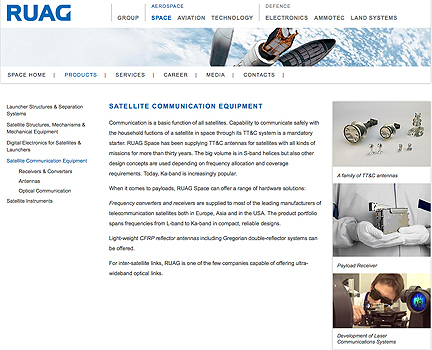[SatNews] No less than 24 RUAG Space antennas at a time will be launched on board the six Globalstar mobile communications satellites scheduled for lift-off from Baikonour, Kazakhztan on October 19, 7:10 p.m. CEST.
The antennas were manufactured by RUAG Space in Gothenburg, Sweden. "This is a unique launch counting six satellites in one go. Every satellite has four antennas for Uplink, Telemetry and Telecommand from us. 24 antennas in one launch must be some kind of a record", says Jan Zackrisson, antenna expert at RUAG Space. The Company, based in Gothenburg, Sweden, has designed and manufactured three different types of antennas for the satellites: A corrugated waveguide antenna for receipt of the C-band uplink and receipt of telecommands and two types of patch excited cup antennas for telemetry and telecommand communication at C-band. The designs are extremely efficient in size and mass. The C-band Transmit Antennas weigh only 19 grams each.
Globalstar is a global-coverage system for mobile phone and data services. Globalstar has suffered some loss of service in the first generation constellation of mobile communication satellites, likely due to radiation damage. This new generation satellites, built by Thales Alenia Space in France and Italy, will have higher communication capacity (256 kbits/s compared to 9,6 Kbits/s), higher reliability through redundancies and a fifteen year service life compared to 7.5 years for the first generation. The new generation satellites also have an improved radiation protection. The full 2G system is designed for 48 satellites in eight orbital planes at 1 414 km with six satellites in each plane. So far, 24 satellites have been ordered and remaining quantity will be ordered after initial in-orbit technical and commercial experiences.
The satellites weigh 700 kg and have 1.7 kW of end-of-life power capacity. The satellites are equipped with 16 C- to S-band transponders and 16 L- to C-band receivers. The first six satellites will be launched by a single Soyuz launch vehicle from Baikonur in Kazakhstan on October 19th. The satellites will be released from a dispenser structure. An additional 18 satellites will be launched in groups of six within the coming year.


